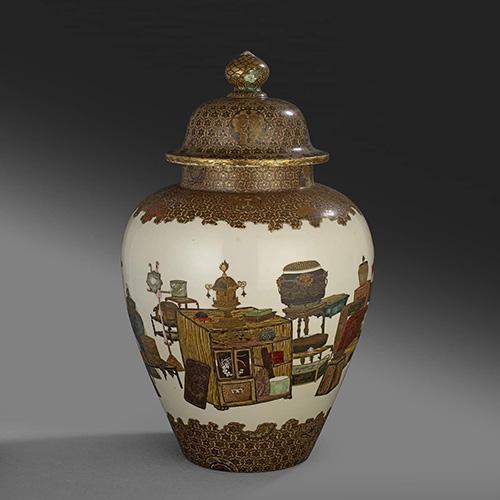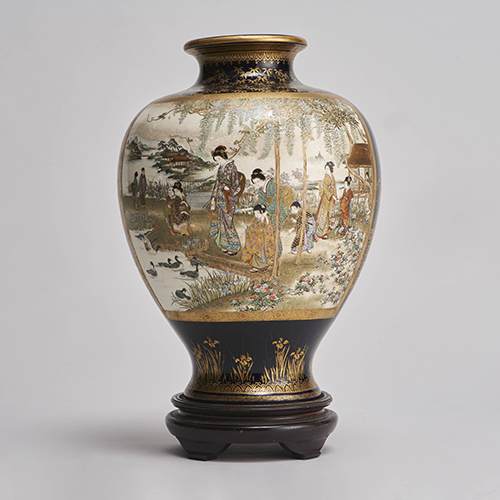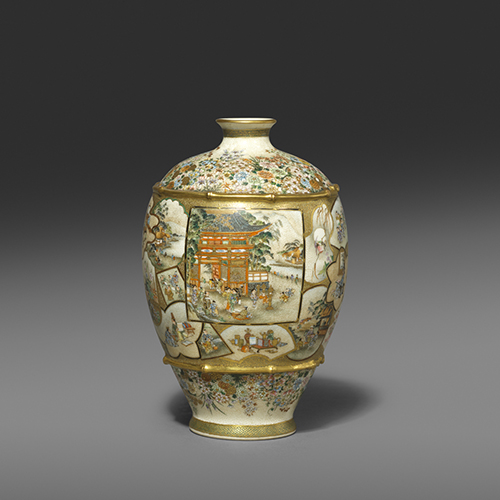

Satsuma ware is a style of Japanese pottery that originated in Satsuma Province in the most southerly of Japan’s four main islands, Kyūshū. However, the roots of the trade stem from the feudal Lord Toyotomi Hideyoshi’s invasion of the Korean peninsula between 1592 and 1598.
Toyotomi enjoyed early success against the Korean armed forces and was able to capture several leading makers of the highly regarded Korean ceramics trade. These master potters were taken back to Japan where they essentially founded the ceramics industry in Kyūshū.
Satsuma province was ideally suited for ceramics production, given the local abundance of clay deposits which provided ample raw material for the area’s kilns. The earliest surviving examples of Satsuma ware or Ko-Satsuma as it is known in Japan, tend to be practical, unadorned pieces for the household market, finished in a simple dark glaze.
The more familiar elaborate patterned ceramics which are synonymous with the region began production in the early 19th century and are known as Kyō-satsuma. This change in direction came about as Kyūshū’s potters sought creative inspiration from their Kyoto counterparts, as well as the artists of Japan’s famed Kanō school of painting.
 Having perfected the techniques of overglaze painting, Satsuma’s ceramicists began replicating the Kano and Kyoto styles, producing bright, intricate patterned porcelain. Usually depicting birds or floral motifs, their designs incorporated a rainbow of colours, applied on an ivory ground, and often enhanced with the application of delicate gilding.
Having perfected the techniques of overglaze painting, Satsuma’s ceramicists began replicating the Kano and Kyoto styles, producing bright, intricate patterned porcelain. Usually depicting birds or floral motifs, their designs incorporated a rainbow of colours, applied on an ivory ground, and often enhanced with the application of delicate gilding.
The popularity of Satsuma ware products rose sharply in Japan and when Satsuma ceramics were showcased prominently at the Exposition Universelle of 1867 in Paris, Kyūshū’s most popular export found a whole new audience of collectors in Europe and North America.
Demand was so great in fact that in a very short time Satsuma ware became one of Japan’s most lucrative exports. Encourage by the new Meiji regime, new factories opened across the country to cope with the burgeoning popularity.
Satsuma ware products were manufactured in cities such as Tokyo, Kobe and Yokahama. Consequently, for the first time, the name Satsuma symbolised a style of ceramic, rather than denoting the location of the item’s origin.
 Overseas sales of Satsuma ware were so prolific that Emperor Meiji (reigned 1868-1912) was able to fund many of his reforms from the resulting revenue. Sadly, with high demand came a compromising of quality with mass production techniques and an overreliance on cliched themes such as pagodas and figures in traditional Japanese dress designed to appeal to the Western market.
Overseas sales of Satsuma ware were so prolific that Emperor Meiji (reigned 1868-1912) was able to fund many of his reforms from the resulting revenue. Sadly, with high demand came a compromising of quality with mass production techniques and an overreliance on cliched themes such as pagodas and figures in traditional Japanese dress designed to appeal to the Western market.
This decline in quality, combined with changing consumer tastes would ultimately bring about a decline in the fashion for Satsuma Ware by the mid-1890s. However, not all factories were willing to compromise their standards. Celebrated makers such as Yabu Meizan and Makuzu Kōzan continued to produce high quality examples, winning international awards for their artistic prowess well into the 20th century.
Click here to view examples of Satsuma ceramics from BADA members.

